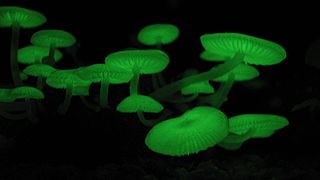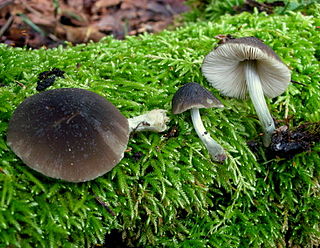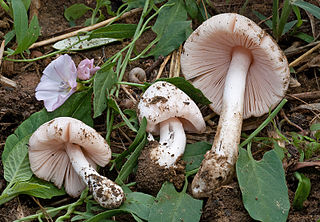
The Pluteaceae are a family of small to medium-sized mushrooms which have free gill attachment and pink spores. Members of Pluteaceae can be mistaken for members of Entolomataceae, but can be distinguished by the angled spores and attached gills of the Entolomataceae. The four genera in the Pluteaceae comprise the widely distributed Volvariella and Pluteus, the rare Chamaeota, and Volvopluteus, which was newly described in 2011 as a result of molecular analysis. The Dictionary of the Fungi estimates there are 364 species in the family.

Pluteus cervinus, commonly known as the deer shield, deer mushroom, or fawn mushroom, is a species of fungus in the order Agaricales. Fruit bodies are agaricoid (mushroom-shaped). Pluteus cervinus is saprotrophic and fruit bodies are found on rotten logs, roots, tree stumps, sawdust, and other wood waste. The species is common in Europe and eastern North America, but rare and possibly introduced in western North America.

Pier Andrea Saccardo was an Italian botanist and mycologist. He was also the author of a color classification system that he called Chromotaxia. He was elected to the Linnean Society in 1916 as a foreign member. His multi-volume Sylloge Fungorum was one of the first attempts to produce a comprehensive treatise on the fungi which made use of the spore-bearing structures for classification.

Pluteus salicinus is a European psychedelic mushroom that grows on wood. It is an edible mushroom after parboiling.

Melanoleuca is a poorly known genus of saprotrophic mushrooms traditionally classified in the family Tricholomataceae. Most are small to medium sized, white, brown, ocher or gray with a cylindrical to subcylindrical stipe and white to pale yellowish gills. The basidiospores are ellipsoid and ornamented with amyloid warts. Melanoleuca is considered a difficult group to study due to their macroscopic similarities among species and the need of a thorough microscopic analysis to separate species. DNA studies have determined that this genus is closely related to Amanita and Pluteus and that it does not belong to the family Tricholomataceae.
Pluteus brunneidiscus is a species of agaric fungus in the family Pluteaceae. It was first described scientifically by American mycologist William Alphonso Murrill in 1917. It is found in Europe (Spain) and North America.

Pluteus cyanopus is a species of agaric fungus in the family Pluteaceae. Found in Africa, Europe, and North America, its fruit bodies contain the psychoactive compounds psilocybin and psilocin. The species was first described scientifically by French mycologist Lucien Quélet in 1883.
Pluteus glaucus is a mushroom in the family Pluteaceae.
Pluteus nigroviridis is a mushroom in the family Pluteaceae. Found in Europe, it was first described scientifically by Hungarian mycologist Margit Babos in 1983.

Volvopluteus is a genus of small to medium-sized or big saprotrophic mushrooms growing worldwide. The genus has been segregated from Volvariella with which it shares some morphological characteristics such as the presence of a volva and a pink to pink-brown spore print. Phylogenetic analyses of DNA data have shown that Volvopluteus is closely related to Pluteus and both genera currently are classified in the family Pluteaceae, while Volvariella is not closely related to either genus and its position in the Agaricales is still uncertain.

Leucocoprinus fragilissimus, commonly known as the fragile dapperling, is a species of gilled mushroom in the family Agaricaceae.

Mycena chlorophos is a species of agaric fungus in the family Mycenaceae. First described in 1860, the fungus is found in subtropical Asia, including India, Japan, Taiwan, Polynesia, Indonesia, and Sri Lanka, in Australia, and Brazil. Fruit bodies (mushrooms) have pale brownish-grey sticky caps up to 30 mm (1.2 in) in diameter atop stems 6–30 mm (0.2–1.2 in) long and up to a millimeter thick. The mushrooms are bioluminescent and emit a pale green light. Fruiting occurs in forests on fallen woody debris such as dead twigs, branches, and logs. The fungus can be made to grow and fruit in laboratory conditions, and the growth conditions affecting bioluminescence have been investigated.

Pluteus phaeocyanopus is an agaric fungus in the family Pluteaceae. Described as a new species in 2010, it has only been collected from California, where it grows singularly or in groups on the decaying wood of oak. The fruit body has a smooth brown cap measuring 2–4 cm (0.8–1.6 in) in diameter. The stipe is 2–5 cm (0.8–2.0 in) long by 0.4–0.8 cm (0.16–0.31 in) thick, and roughly equal in width throughout. It is whitish but becomes grayish-green near the base. The thin and fragile gills are free from attachment to the stipe, close to somewhat distantly placed, and interspersed with several tiers of lamellulae. The flesh has no distinctive taste or odor. The spores are spherical or nearly so and measure 6.2–8.4 by 5.7–7.9 μm.

Volvopluteus earlei is a species of mushroom in the family Pluteaceae. It was originally described in 1911 by American mycologist William Alphonso Murrill as Volvariopsis earlei, based on collections made in a Cuban banana field. The fungus was later shuffled to the genera Volvaria and Volvariella before molecular studies placed it in Volvopluteus, a genus newly described in 2011.

Volvopluteus michiganensis is a species of mushroom in the family Pluteaceae. It was originally described under the name Pluteus michiganensis but molecular studies have placed it in the Volvopluteus, a genus described in 2011. The cap of this mushroom is about 7–9 cm (2.8–3.5 in) in diameter, gray, and has a cracked margin that is sticky when fresh. The gills start out as white but they soon turn pink. The stipe is white and has a volva at the base. Microscopical features and DNA sequence data are of great importance for separating this taxon from related species. V. michiganensis is a saprotrophic fungus that was originally described as growing on sawdust. It has only been reported from Michigan (US) and the Dominican Republic.
Pluteus velutinus is a species of agaric fungus in the family Pluteaceae. Described as new to science in 2012, it is found in India.
Pluteus brunneosquamulosus is a species of agaric fungus in the family Pluteaceae. It is found in India.
Margit Babos was a Hungarian mycologist born on 28 October 1931 in Budapest. She became one of the most widely recognized mycologists in the second half of the 20th century in Eastern Europe, with contributions to mycological research, fungal taxonomy and recording the mycoflora of Hungary.
Cerocorticium molle is a species of crust fungus in the family Meruliaceae.











